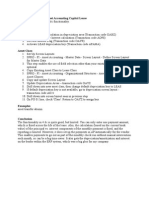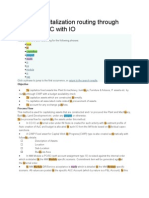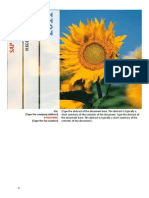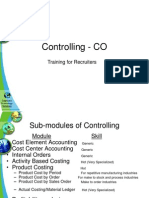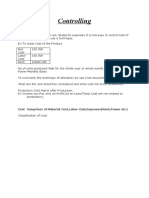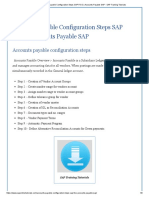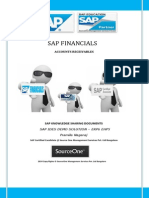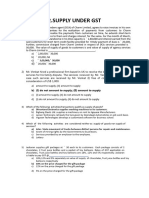Sap & Finance - Sap Fico Interview Questions - Product Costing
Sap & Finance - Sap Fico Interview Questions - Product Costing
Uploaded by
A KCopyright:
Available Formats
Sap & Finance - Sap Fico Interview Questions - Product Costing
Sap & Finance - Sap Fico Interview Questions - Product Costing
Uploaded by
A KOriginal Description:
Original Title
Copyright
Available Formats
Share this document
Did you find this document useful?
Is this content inappropriate?
Copyright:
Available Formats
Sap & Finance - Sap Fico Interview Questions - Product Costing
Sap & Finance - Sap Fico Interview Questions - Product Costing
Uploaded by
A KCopyright:
Available Formats
1/6/2015
SAP&FINANCE:SAPFICOINTERVIEWQUESTIONSProductCosting
0
More NextBlog
SAP&FINANCE
SAPFICOINTERVIEWQUESTIONSProductCosting
CONTENT
SAPFICOSTUDYMATERIAL
SAPIFRS
Product Costing
SAPSEPA
SAPFICOINTERVIEWQUESTIONS
What are the important Terminologies in Product Costing?:
Results Analysis Key This key determines how the Work in Progress is
calculated
Cost Components The break up of the costs which get reflected in
the product costing eg. Material Cost, Labour Cost, Overhead etc
Costing Sheets This is used to calculate the overhead in
Controlling
Costing Variant For All manufactured products the price control
recommended is Standard Price. To come up with this standard price for
the finished good material this material has to be costed. This is done
using Costing Variant. Further questions down below will explain this
concept better.
What are the configuration settings maintained in the costing
variant?
Costing variant forms the link between the application and Customizing,
since all cost estimates are carried out and saved with reference to a
costing variant. The costing variant contains all the control parameters
for costing.
The configuration parameters are maintained for costing type, valuation
variants, date control, and quantity structure control.
In costing type we specify which field in the material master should be
updated.
In valuation variant we specify the following
a) the sequence or order the system should go about accessing
prices for the material master (planned price, standard price,
moving average price etc).
b) It also contains which price should be considered for activity price
calculation and .
c) How the system should select BOM and routing.
How does SAP go about costing a Product having multiple Bill of
materials within it?
SAP first costs the lowest level product, arrives at the cost and then goes
and cost the next highest level and finally arrives at the cost of the final
product.
What does the concept of cost roll up mean in product costing
context?
The purpose of the cost roll up is to include the cost of goods
manufactured of all materials in a multilevel production structure at the
topmost level of the BOM(Bill of Material)
The costs are rolled up automatically using the costing levels.
1) The system first calculates the costs for the materials with the
lowest costing level and assigns them to cost components.
2) The materials in the next highest costing level (such as semifinished
materials) are then costed. The costs for the materials
costed first are rolled up and become part of the material costs of
the next highest level.
What is a settlement profile and why is it needed?
All the costs or revenues which are collected in the Production order or
Sales order for example have to be settled to a receiver at the end of the
http://sapfinance.blogspot.com/2011/02/sapficointerviewquestionsproduct.html
1/8
1/6/2015
SAP&FINANCE:SAPFICOINTERVIEWQUESTIONSProductCosting
period. This receiver could be a Gl account, a cost center, profitability
analysis or asset. Also read the question What is a cost object in the
section Controlling.
In order to settle the costs of the production order or sales order a
settlement profile is needed.
In a settlement profile you define a range of control parameters for
settlement. You must define the settlement profile before you can enter a
settlement rule for a sender.
The Settlement Profile is maintained in the Order Type and defaults
during creating of order.
.
Settlement profile includes:
1) the retention period for the settlement documents.
2) Valid receivers GL account, cost center, order, WBS element, fixed
asset, material, profitability segment, sales order, cost objects, order
items, business process
3) Document type is also attached here
4) Allocation structure and PA transfer structure is also attached to the
settlement profile e.g. A1
The settlement profile created is then attached to the order type.
What is Transfer or Allocation structure?
The transfer structure is what helps in settling the cost from one cost
object to the receiver. It is maintained in the Settlement profile defined
above.
The Transfer structure has 2 parts:
a) Source of cost elements you want to settle
b) Target receiver whether it is a Profitability segment or fixed asset or
cost center
So basically for settling the costs of a cost object you need
to define the Transfer structure where you mention what
are the costs you want to settle and the target receiver for
that.
This information you fit it in the settlement profile which
contains various other parameters and this settlement
profile is defaulted in the Order type. So every time a
order is executed the relevant settlement rule is stored
and at the month end by running the transaction of the
settlement of orders all the cost is passed on to the
receiver
So to put in simple terms:
a) You define your cost object which could be a
production order a sales order for eg
b) You collect costs or revenues for it
c) You determine where you want to pass these costs or
revenues to for eg if the sales order is the cost object
all the costs or revenues of a sales order could be
passed to Profitability Analysis
What do you mean by primary cost component split?
Primary cost split is defined when you create a cost component
structure. When you switch on this setting, the primary cost from the
cost center are picked up and assigned to the various cost components.
How do primary costs get picked up from cost center into the cost
component structure?
This is possible when you do a plan activity price calculation from SAP.
The primary cost component structure is assigned to the plan version 0
in Controlling .
Is it possible to configure 2 cost component structures for the same
product in order to have 2 different views?
Yes it is possible. We create another cost component structure and
assign it to the main cost component structure. This cost component
http://sapfinance.blogspot.com/2011/02/sapficointerviewquestionsproduct.html
2/8
1/6/2015
SAP&FINANCE:SAPFICOINTERVIEWQUESTIONSProductCosting
structure is called Auxiliary cost component structure which provides
another view of the cost component structure.
How do you go about configuring for the sales order costing?
The flow is as follows:
Sales order > Requirement TypeRequirement Class> All settings for
controlling
In a sales order you have a requirement type .In configuration, the
requirement Class is attached to the requirement type and in this
requirement class all configuration settings are maintained for
controlling.
In the requirement class we attach the costing variant, we attach the
condition type EK02 where we want the sales order cost to be updated,
and the account assignment category. In the account assignment
category we define whether the sales order will carry cost or not. In case
if we do not want to carry cost on the sales order we keep the
consumption posting field blank.
We also define here the Results Analysis version which helps to calculate
the Results Analysis for the Sales order if required.
There are 2 plants in a company code. First plant is the
manufacturing plant and another plant is the selling plant. Finished
goods are manufactured at the manufacturing plant and transferred
to the selling plant. How is standard cost estimate calculated at the
selling plant given the fact that the cost at both the plant should be
the same?
The special procurement type needs to be configured which specifies in
which plant the system is to look up for cost. Here a special procurement
key specifying plant 1 (manufacturing plant) should be configured.
This special procurement type must be entered in the costing view or the
MRP view of the Finished good material master record in plant 2.
When you cost the finished good at plant 2, the system will transfer the
standard cost estimate from plant 1 to plant 2
What is mixed costing in SAP? Give an example to explain.
Mixed costing is required when different processes are used to
manufacture the same material. Mixed costing is required when you have
different sources of supply for purchasing the material.
Let us take an example:
There is a finished good Xylene which can be manufactured by 3
different processes.
The first process uses an old machine and labour. The processing time is
9 hrs to manufacture.
The second process uses a semiautomatic machine and labour. The
processing time is 7 hrs to manufacture.
The third process uses a fully automatic machine and the processing
time is 5 hrs.
Thus cost of manufacture for the 3 processes is different. By using Mixed
costing you can create a mixed price for the valuation of this finished
good.
What configuration needs to done for using Mixed costing?
Quantity Structure type for mixed costing must be configured. Here we
specify the time dependency of the structure type . The following options
exist
a) You have no time dependency.
b) It is based on fiscal year
c) It is based on period
This quantity structure type is then assigned to the costing version.
Lets say for a product there exists three production versions.
Explain the process how you would go about creating a mixed cost
estimate?
The process of creating a Mixed cost estimate would be as follows:
1) Create procurement alternatives for each of the production version.
2) Define Mixing ratios for the procurement alternatives
3) Select the configured quantity structure type and execute a
material cost estimate based on the costing version.
http://sapfinance.blogspot.com/2011/02/sapficointerviewquestionsproduct.html
3/8
1/6/2015
SAP&FINANCE:SAPFICOINTERVIEWQUESTIONSProductCosting
What is Mixing ratios and why are they required to be maintained
before creation of cost estimate?
Mixing ratios are weighting factors assigned to the procurement
alternatives. This weighting factor is obtained from the planning
department based on the usage of the procurement alternatives during
the planning year.
For e.g.
Procurement alternative 1 (production version 1) 40% will be
manufactured
Procurement alternative 2 (production version 2) 35% will be
manufactured
Procurement alternative 3 (production version 3) 25% will be
manufactured
This % will be maintained as mixing ratios.
Thus when system calculates the mixed cost estimate, system will first
cost each of the production version and then multiply each of the costs
with the weighting factors.
Thus
240 (cost of prod. Vers 1) X 40 = 9600
210 (cost of prod. Vers 2) X 35 = 7350
160 (cost of prod vers 3) X 25 = 4000
Mixed costs 17350/100 = 173.5
There are Result analysis categories in WIP (Work in Process). What
do you mean by the result analysis category Reserves for unrealized
costs?
If you are calculating the work in process at actual costs, the system will
create reserves for unrealized costs if the credit for the production order
based on goods receipts is greater than the debit of the order with actual
costs incurred. The Result analysis category RUCR (Reserves for
unrealized cost) would need to be maintained. Normally this is not
maintained in most of the companies.
Which is the Result analysis category which is normally maintained
for the WIP (Work in Process) calculation?
The Result analysis category WIPR Work in process with requirement
to capitalize costs is normally maintained for WIP calculation
How do you define a Byproduct in SAP?
A Byproduct in SAP is defined as an item with a negative quantity in the
Bill of Material. Byproduct reduces the cost of the main product. There
is no Bill of Material for a Byproduct.
How do you calculate the cost for a Byproduct in SAP?
The cost for the Byproduct is the net realizable value. This is manually
maintained in the system for the byproduct through transaction code
MR21 Price change.
How do you define a CoProduct in SAP?
A Coproduct (primary product or byproduct) is indicated by a tick in
the costing view of the material master. In the BOM all the primary
products are represented as an item with negative quantity. A primary
product is also indicated as a coproduct in the BOM of the leading coproduct.
For primary products the costs are calculated using the
apportionment method, while for byproducts the net realizable value
method applies.
Is it possible to use Standard SAP Coproduct functionality in
Repetitive manufacturing?
No. It is not possible to use the Standard Coproduct functionality in
repetitive manufacturing
How do you got about defining COProduct functionality in
Repetitive manufacturing?
In the Repetitive manufacturing you need to use the Costing BOM for the
other coproduct. Through arithmetical calculation you need to maintain
the quantities in the costing BOM. This coproduct will be shown as a
negative item in the leading coproduct.
http://sapfinance.blogspot.com/2011/02/sapficointerviewquestionsproduct.html
4/8
1/6/2015
SAP&FINANCE:SAPFICOINTERVIEWQUESTIONSProductCosting
You get an error while executing a cost estimate which says Item
no 1 (which is a raw material) is not assigned to the cost component
structure?
What could be the possible cause of error in this scenario?
The consumption GL code for the material master is not assigned to the
cost component structure. To find out how you can know which GL code
to assign read the next question.
In the above scenario how do you know which cost element is being
called for?
In this case you need to the use simulation mode OMWB in MM and
enter the material code plant and the movement type 261 (issue against
production order). You will see the account modifier VBR and against
which the GL code is available.
You get an error while executing a cost estimate, which says Item
no. 1 (which is a raw material) is not assigned to the cost
component structure?
In this case everything is perfectly configured, what could be the
possible error in this scenario?
In the material master of the raw material the valuation class updated in
the accounting view will be incorrect.
Is it possible to calculate standard cost estimate for a past date?
No. It is not possible to calculate standard cost estimate for a past date.
What is the difference between a product cost collector and
production order?
Both of these are cost objects which collect production costs for
manufactured product. Product cost collector is a single order created for
a material. All the costs during the month for that material is debited to
single product cost collector. No costing by lot size is required in case of
product cost collector.
The latter is where there are many production orders for a single material
during the month. Costs are collected on each of this production order.
Costing by lot size is the main requirement in case of production orders.
What is the meaning of preliminary cost estimate for product cost
collector?
Preliminary costing in the product cost by period component calculates
the costs for the product cost collector. In repetitive manufacturing you
can create cost estimate for specific production version.
Why is preliminary cost estimate required?
The preliminary cost estimate is required for the following:
Confirm the actual activity quantities.
Valuate work in process
Calculate production variances in variance calculation
Valuate the unplanned scrap in variance calculation
Is it possible to update the results of the standard cost estimate to
other fields such as commercial price, tax price fields in the
accounting view?
Yes. It is possible to update the standard cost estimate to other fields
such as commercial price etc. in accounting view.
How do you configure that the results of the standard cost estimate
are updated in other fields other than the standard price?
The price update in the material master is defined in Costing type. This
costing type is attached to the costing variant.
What do you mean by Assembly scrap and how is it maintained in
SAP?
Assembly scrap is scrap that is expected to occur during the production
of a material which is used as an assembly.
If a certain amount of scrap always occurs during the production of an
http://sapfinance.blogspot.com/2011/02/sapficointerviewquestionsproduct.html
5/8
1/6/2015
SAP&FINANCE:SAPFICOINTERVIEWQUESTIONSProductCosting
assembly, the quantities and activities used must be increased by the
system so that the required lot size can be produced.
To increase the lot size of an assembly you can enter a percentage, flatrate
assembly scrap in the MRP 1 view of the material master record.
This assembly scrap is reflected in all the subordinate components. The
system increases the quantity to be produced by the calculated scrap
quantity. This increases both the materials consumed and the activities
consumed and consequently the cost.
How are scrap costs shows in the standard cost estimate?
Scrap costs are assigned to the relevant cost component and can be
shown separately for a material in the costed multilevel BOM.
How are scrap variances calculated?
Scrap variance are calculated by valuating the scrap quantities with the
amount of the actual costs less the planned scrap costs.
What do you mean by Component scrap and how is it maintained in
SAP?
Component scrap is the scrap of a material that is expected to occur
during production. When an assembly is produced with this component,
the system has to increase the component quantity to enable to reach
the required lot size. The component scrap can be entered in the BOM
item or in the MRP 4 view of the material master
What do you mean by Operation scrap and how is it maintained in
SAP?
Operation scrap is a scrap that is expected to occur during production.
Operation scrap is used to reduce the planned input quantities in follow
up operations and to calculate the precise amount of assembly scrap.
Operation scrap can be maintained in % in the routing and in the BOM.
What are the implications if the operation scrap is maintained in
the routing and if it maintained in the BOM?
If the operation scrap is maintained only in the routing, the costing lot
size is reduced by this percentage.
If the operation scrap is maintained in the BOM, the planned input (not
the output quantity) is increased and any assembly scrap is reduced.
What is the meaning of additive costs in SAP and why is it required?
Additive costs are used to add costs manually to a material cost estimate
when it cannot be calculated by the system. Examples of such costs are
freight charges, insurance costs and stock transfer costs.
What is the configuration required for additive costs?
To include additive costs in the material cost estimate you need to set the
indicator Incl. additive costs for each valuation strategy in the valuation
variant.
Further you also need to set in the costing variant to include additive
costs.
How do you configure split valuation?
The configuration steps involved in split valuation:
1) Activate split valuation Configure whether split valuation is
allowed for the company code.
2) Determine the valuation categories and valuation types that are
allowed for all valuation areas.
3) Allocate the valuation types to the valuation categories
4) Determine the local valuation categories for each valuation area
and activate the categories to be used in your valuation area.
What is valuation category and valuation type in split valuation?
In split valuation the material stock is divided according to valuation
category and valuation type.
Valuation category determines how the partial stocks are divided
according to which criteria. The following valuation categories are preset
in the standard SAP R/3 system
B Procurement type
H Origin type
http://sapfinance.blogspot.com/2011/02/sapficointerviewquestionsproduct.html
6/8
1/6/2015
SAP&FINANCE:SAPFICOINTERVIEWQUESTIONSProductCosting
X Automatic batch valuation
Valuation type describes the characteristic of individual stock.
e.g. EIGEN Inhouse production (SAP standard)
FREMD External procurement (SAP standard)
Valuation types are assigned to valuation categories.
What are the steps involved before you run a cost estimate for a
split valuated material?
The following are the steps:
1) Create procurement alternatives based on the valuation types for
the material.
2) Maintain Mixing ratios for the procurement alternatives
How do you create a material master with split valuation?
To create a split valuated material master proceed as follows:
1. First create a valuation header record for the material. Update the
Valuation category field on the accounting screen leave the
Valuation type field blank. In the Price control field, enter V
(moving average price). When you save, the system creates the
valuation header record.
2. Then create the material for a valuation type.
Call up the same material in creation mode again. Due to the fact
that a valuation header record exists, the system requires you to
enter a valuation type for the valuation category.
3. Repeat Step two for every valuation type planned.
When a standard cost estimate is run for a finished good does SAP
calculate cost estimate for its components such as raw and packing
material?
Yes. SAP calculates the cost estimate even for raw and packing material
and stores it in the standard price field for information purposes
How do you prevent the system from calculating the cost estimate
for raw and packing material when you run a standard cost estimate
for the finished goods?
To prevent the system from calculating cost estimates for raw and
packing material, you need to select the No costing checkbox in the
costing view of the material master.
How is it possible to apply 2 different overhead rates for 2 different
finished goods?
It is possible through overhead groups. You configure 2 overhead keys.
Define rates for each of this overhead key. These two overhead keys is
then assigned to the two overhead groups. These overhead groups are
attached in the costing view of the finished goods material
Recommend this on Google
Reactions:
funny (0)
interesting (0)
cool (0)
4comments:
ranjithreddy 12February2014at11:38
Greatdocument..
Reply
ShashiHitlalli 12March2014at22:11
Wonderfulinformation....sufficient.....
Reply
Sathyadiravikishore 15May2014at00:20
verywellexplained
Reply
SankarGonela 2January2015at00:57
http://sapfinance.blogspot.com/2011/02/sapficointerviewquestionsproduct.html
7/8
1/6/2015
SAP&FINANCE:SAPFICOINTERVIEWQUESTIONSProductCosting
goodinformation
Reply
Enteryourcomment...
Commentas:
GoogleAccount
Publish
Preview
Linkstothispost
CreateaLink
NewerPost
Home
OlderPost
Subscribeto:PostComments(Atom)
SHAREIT
SharethisonFacebook
Tweetthis
Viewstats
(NEW)Appointmentgadget>>
TOTALPAGEVIEWS
ABOUTME
129,000
SandeepLakhera
Viewmycompleteprofile
PictureWindowtemplate.PoweredbyBlogger.
http://sapfinance.blogspot.com/2011/02/sapficointerviewquestionsproduct.html
8/8
You might also like
- Rural Marketing by Pradeep KashyapDocument346 pagesRural Marketing by Pradeep KashyapTanu Shree Shaw82% (11)
- SAP Enterprise Structure Concept and Configuration Guide: A Case StudyFrom EverandSAP Enterprise Structure Concept and Configuration Guide: A Case StudyRating: 5 out of 5 stars5/5 (3)
- SAP Variant Configuration: Your Successful Guide to ModelingFrom EverandSAP Variant Configuration: Your Successful Guide to ModelingRating: 5 out of 5 stars5/5 (2)
- SAP CO Controlling Mangement Account Business Process Master ListDocument2 pagesSAP CO Controlling Mangement Account Business Process Master Listsaaisun100% (3)
- COPA Activate Account BasedDocument2 pagesCOPA Activate Account BasedJit GhoshNo ratings yet
- Dunning, Dunning Procedure in SAPDocument3 pagesDunning, Dunning Procedure in SAPmr_relyNo ratings yet
- Configuration of SAP Asset Accounting Capital LeaseDocument1 pageConfiguration of SAP Asset Accounting Capital Leaseneverever143100% (3)
- KE30 Execute Profitability ReportDocument18 pagesKE30 Execute Profitability ReportReddy BDNo ratings yet
- New GL and Classic GLDocument3 pagesNew GL and Classic GLRizky Wahyu100% (1)
- SAP Foreign Currency Revaluation: FAS 52 and GAAP RequirementsFrom EverandSAP Foreign Currency Revaluation: FAS 52 and GAAP RequirementsNo ratings yet
- SAP CONTROLLING - PRODUCT COSTING PART-1 - SAP BlogsDocument47 pagesSAP CONTROLLING - PRODUCT COSTING PART-1 - SAP BlogssapppqmmanloNo ratings yet
- Product Costing NotesDocument8 pagesProduct Costing NotesThirunavukkarasu SelvarajNo ratings yet
- What Is The Relation Between A Controlling Areas and A Company CodeDocument27 pagesWhat Is The Relation Between A Controlling Areas and A Company CodeManjunathreddy SeshadriNo ratings yet
- Cost Element Accounting SAPDocument3 pagesCost Element Accounting SAPElektrocultureNo ratings yet
- SAP - GL Interview Questions: Posted Automatically Through The System and How Is This Defined in The System?Document9 pagesSAP - GL Interview Questions: Posted Automatically Through The System and How Is This Defined in The System?Amarnath ReddyNo ratings yet
- Create Financial Statement Versions in SAPDocument9 pagesCreate Financial Statement Versions in SAPSandeep KonarNo ratings yet
- Capital Investment OrdersDocument7 pagesCapital Investment OrdersSujith Kumar33% (3)
- Sap Fico Interview Questions On Fixed AssetsDocument7 pagesSap Fico Interview Questions On Fixed AssetsPavan UlkNo ratings yet
- S - ALR - 87012284 - Financial Statements & Trial BalanceDocument9 pagesS - ALR - 87012284 - Financial Statements & Trial Balancessrinivas64No ratings yet
- Internal Order AccountingDocument24 pagesInternal Order AccountingRanjith Kumar RotaractorNo ratings yet
- Profitability Analysis Co-PaDocument47 pagesProfitability Analysis Co-PaBHAVESHDESAI82No ratings yet
- 02 CO HANA - S4 HANA StructureDocument6 pages02 CO HANA - S4 HANA StructureAlwar Senthil KumaranNo ratings yet
- Sap Fico Interview Questions - Fi GLDocument4 pagesSap Fico Interview Questions - Fi GLvijayalakshmiNo ratings yet
- COPA Configuration and Painter GuideDocument217 pagesCOPA Configuration and Painter Guideresky surbakti0% (1)
- Assets Capitalization Routing Through CWIP or AuC With IODocument3 pagesAssets Capitalization Routing Through CWIP or AuC With IORavindra Jain100% (2)
- End User Document CoDocument64 pagesEnd User Document Cobattinisantosh_19774No ratings yet
- Top 20 SAP FICO Interview Questions and Answers PDF - SVRDocument10 pagesTop 20 SAP FICO Interview Questions and Answers PDF - SVRManas Kumar SahooNo ratings yet
- FI Project in SAPDocument75 pagesFI Project in SAPmani254722305100% (2)
- PM Order Revaluation Actual Activity CostDocument9 pagesPM Order Revaluation Actual Activity CostGovardhan MaileNo ratings yet
- Controlling CO Training For RecruitersDocument26 pagesControlling CO Training For RecruiterssreekumarNo ratings yet
- Rel - My SAP CO Material FullDocument284 pagesRel - My SAP CO Material Fullkalicharan1350% (2)
- Document Splitting in SAP New GLDocument4 pagesDocument Splitting in SAP New GLAmin raufiNo ratings yet
- COPA Interview QuestionsDocument6 pagesCOPA Interview QuestionsPriyaNo ratings yet
- SAP Internal OrderDocument1 pageSAP Internal Order296141No ratings yet
- SAP-CO-Internal Order Configuration Guide: Jayanth MaydipalleDocument36 pagesSAP-CO-Internal Order Configuration Guide: Jayanth MaydipalleNagarajan100% (1)
- Cross Company Code IssueDocument12 pagesCross Company Code IssueSATYANARAYANA MOTAMARRINo ratings yet
- What Is SAP COPA?: Key Components in SAP CO-PADocument2 pagesWhat Is SAP COPA?: Key Components in SAP CO-PAHimanshu TalwarNo ratings yet
- Sap-Fi/Co: Areas To Be Covered Under FI/CO FIDocument22 pagesSap-Fi/Co: Areas To Be Covered Under FI/CO FIBeema RaoNo ratings yet
- Document Splitting in New General LedgerDocument21 pagesDocument Splitting in New General LedgerRakesh Gupta100% (1)
- Controlling: Cost AccountingDocument144 pagesControlling: Cost AccountingBharat WealthNo ratings yet
- SAP Controlling Question & Answer Session (11 April 2020)Document9 pagesSAP Controlling Question & Answer Session (11 April 2020)Sam RathodNo ratings yet
- Internal Order in S4 HanaDocument6 pagesInternal Order in S4 HanaAtul Madhusudan100% (1)
- Asset Accounting IssueDocument17 pagesAsset Accounting IssueAtulWalvekarNo ratings yet
- SAP Controlling - Internal OrderDocument40 pagesSAP Controlling - Internal OrderpavankalluriNo ratings yet
- Accounts Payable Configuration Steps SAP FICO - Accounts Payable SAP - SAP Training TutorialsDocument9 pagesAccounts Payable Configuration Steps SAP FICO - Accounts Payable SAP - SAP Training Tutorialsraja babuNo ratings yet
- Sap S4 Hana Co ChangesDocument4 pagesSap S4 Hana Co ChangesViivekcanandu MethriNo ratings yet
- Cats IntrviewDocument4 pagesCats IntrviewmadanaganeshNo ratings yet
- Q. 01 Explain The Client Concept of SAP?Document35 pagesQ. 01 Explain The Client Concept of SAP?Nithin JosephNo ratings yet
- Financial Statement VersionDocument19 pagesFinancial Statement VersionEmegteiNo ratings yet
- Sap Fico Real Time Issues Solutions PDFDocument2 pagesSap Fico Real Time Issues Solutions PDFumeshkjagtap67% (3)
- SAP Financials Accounts ReceivablesDocument17 pagesSAP Financials Accounts ReceivablesAyubPinjarNo ratings yet
- Depreciation KeysDocument54 pagesDepreciation KeysVinod NairNo ratings yet
- SAP FICO Interview QuestionsDocument6 pagesSAP FICO Interview Questionskamal rajNo ratings yet
- Mysap Fi Fieldbook: Fi Fieldbuch Auf Der Systeme Anwendungen Und Produkte in Der DatenverarbeitungFrom EverandMysap Fi Fieldbook: Fi Fieldbuch Auf Der Systeme Anwendungen Und Produkte in Der DatenverarbeitungRating: 4 out of 5 stars4/5 (1)
- NASBA UAA Exposure Draft: Extending The CPA Exam Window To 24 MonthsDocument5 pagesNASBA UAA Exposure Draft: Extending The CPA Exam Window To 24 MonthsAdrienne GonzalezNo ratings yet
- Week 7 - UTS Project - Reviewing Article TemplateDocument13 pagesWeek 7 - UTS Project - Reviewing Article TemplateFauzia AzzahraNo ratings yet
- Supply Under GSTDocument6 pagesSupply Under GSTpujitha vegesnaNo ratings yet
- Resturant BudgetDocument9 pagesResturant BudgetRuki BhamzNo ratings yet
- Saudi Jobs 12.07.2020Document81 pagesSaudi Jobs 12.07.2020Adnan SayyedNo ratings yet
- American Society of Safety Professionals (ASSP) Professional SafetyDocument6 pagesAmerican Society of Safety Professionals (ASSP) Professional SafetyMehedi HasanNo ratings yet
- Assignment 3 MNGT-3711 Stakeholders in Sustainable Business TransformationDocument14 pagesAssignment 3 MNGT-3711 Stakeholders in Sustainable Business TransformationSam rockzsNo ratings yet
- ZP Setup GuideDocument44 pagesZP Setup GuideguptagauravNo ratings yet
- Eastboro Case Write Up For Presentation1Document4 pagesEastboro Case Write Up For Presentation1Paula Elaine ThorpeNo ratings yet
- Vu Huong Ly TopCV - VN 280520.113930Document1 pageVu Huong Ly TopCV - VN 280520.113930Ly VũNo ratings yet
- Inquiry Removal Dispute KitDocument6 pagesInquiry Removal Dispute KitShan Ahmed100% (5)
- Safety PolicyDocument2 pagesSafety PolicyCinfaes RufarNo ratings yet
- Ge6075 Professional Ethics in Engineering Unit 5Document65 pagesGe6075 Professional Ethics in Engineering Unit 5sathya priyaNo ratings yet
- Collection of Maritime Press ClippingsDocument34 pagesCollection of Maritime Press Clippingsluisdavid01No ratings yet
- B4registration Summary ReportsDocument2 pagesB4registration Summary ReportsRoderic SobionoNo ratings yet
- Free Project Planner TemplateDocument14 pagesFree Project Planner Templater9 nebulaNo ratings yet
- Annual Report 2020Document71 pagesAnnual Report 2020Md jahied islamNo ratings yet
- This Study Resource Was: Dettol Marketing Mix (4Ps) StrategyDocument6 pagesThis Study Resource Was: Dettol Marketing Mix (4Ps) StrategyAnkit pattnaikNo ratings yet
- The Evolution of Entrepreneurship ThoughtDocument8 pagesThe Evolution of Entrepreneurship ThoughtTomato Menudo100% (1)
- Mark Scheme Nixor Test 1 - As 28:09:24Document6 pagesMark Scheme Nixor Test 1 - As 28:09:24Kashmala KhurramNo ratings yet
- Methods of Payment in International TradeDocument5 pagesMethods of Payment in International Trademaharani.fmpNo ratings yet
- CR5000 Pcb-Design-Master-Training PDFDocument295 pagesCR5000 Pcb-Design-Master-Training PDFviet phuong huynhNo ratings yet
- Thanks For Buying This Guide On How To Get Discounts and SaveDocument9 pagesThanks For Buying This Guide On How To Get Discounts and SaveACC KAONo ratings yet
- Definition of Bank, Banker and CustomerDocument12 pagesDefinition of Bank, Banker and CustomerNathan NakibingeNo ratings yet
- Managerial Economics & Business Strategy: Quantitative Demand AnalysisDocument28 pagesManagerial Economics & Business Strategy: Quantitative Demand AnalysisReno Prima Dirgantara100% (1)
- Industry 4.0 in Logistics and Supply Chain Management: A Systematic Literature ReviewDocument17 pagesIndustry 4.0 in Logistics and Supply Chain Management: A Systematic Literature ReviewSivanantha MurtheeNo ratings yet
- A Study of Financial Performance Evaluation of Banks in IndiaDocument11 pagesA Study of Financial Performance Evaluation of Banks in IndiaRaghav AryaNo ratings yet
- Small Business An Entrepreneurs Plan 6th Edition Knowles Solutions ManualDocument23 pagesSmall Business An Entrepreneurs Plan 6th Edition Knowles Solutions Manualroryytpvk5g100% (34)
- National Woman Commission Act, 2063 (2006)Document12 pagesNational Woman Commission Act, 2063 (2006)जय कृष्णा पाण्डेयNo ratings yet











